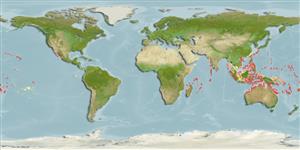Teleostei (teleosts) >
Tetraodontiformes (Puffers and filefishes) >
Monacanthidae (Filefishes)
Etymology: Pervagor: Latin, pervagor = nomadic, itinerant.
Environment: milieu / climate zone / depth range / distribution range
Ecology
Marine; reef-associated; depth range 1 - 25 m (Ref. 9710). Tropical; 31°N - 23°S
Indo-West Pacific: Mauritius, Christmas Island, southern Japan, Marcus Islands, southern Taiwan, Australia, New Caledonia, Marshall Islands, Johnston Island, and Hawaiian Islands; distribution anti-equatorial. Recently reported from Tonga (Ref. 53797). Replaced by Pervagor marginalis in the Line and Marquesas Islands (Ref. 37816).
Size / Weight / Age
Maturity: Lm ? range ? - ? cm
Max length : 13.0 cm TL male/unsexed; (Ref. 30874)
Dorsal spines (total): 1 - 2; Dorsal soft rays (total): 31 - 35; Anal spines: 0; Anal soft rays: 28 - 32. First dorsal spine strong. Posterior margin of ventral flap narrowly attached to large pelvic fin rudiment. Scale spinulation in midbody not closely packed. Body and head color variable; orange to brown iris; caudal fin yellow or orange; soft dorsal and anal fins clear to yellowish; spinous dorsal dark brown to brownish orange; pectorals clear. Numerous spots in head and body appear as dashes or lines Male scale ridge rugosities usually develop at about 60 mm SL.
Inhabits clear lagoon and seaward reefs (Ref. 9710). Solitary among coral and rubble (Ref. 90102). Benthopelagic (Ref. 58302).
Life cycle and mating behavior
Maturity | Reproduction | Spawning | Eggs | Fecundity | Larvae
Hutchins, J.B., 1986. Review of the monacanthid fish genus Pervagor, with descriptions of two new species. Indo-Pac. Fish. (12):35 p. (Ref. 527)
IUCN Red List Status (Ref. 130435: Version 2024-1)
Threat to humans
Harmless
Human uses
Tools
Special reports
Download XML
Internet sources
Estimates based on models
Preferred temperature (Ref.
123201): 25.2 - 29.3, mean 28.4 °C (based on 2416 cells).
Phylogenetic diversity index (Ref.
82804): PD
50 = 0.5039 [Uniqueness, from 0.5 = low to 2.0 = high].
Bayesian length-weight: a=0.01995 (0.00956 - 0.04164), b=2.93 (2.76 - 3.10), in cm total length, based on LWR estimates for this (Sub)family-body shape (Ref.
93245).
Trophic level (Ref.
69278): 2.9 ±0.4 se; based on size and trophs of closest relatives
Resilience (Ref.
120179): High, minimum population doubling time less than 15 months (Preliminary K or Fecundity.).
Fishing Vulnerability (Ref.
59153): Low vulnerability (10 of 100).
Nutrients (Ref.
124155): Calcium = 81.4 [34.6, 206.7] mg/100g; Iron = 0.842 [0.379, 1.975] mg/100g; Protein = 17.9 [15.7, 20.1] %; Omega3 = 0.108 [0.050, 0.226] g/100g; Selenium = 27.4 [13.1, 63.0] μg/100g; VitaminA = 70.8 [19.7, 262.7] μg/100g; Zinc = 1.65 [1.06, 2.63] mg/100g (wet weight);
